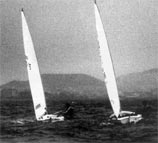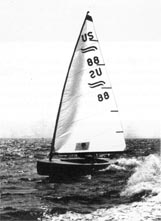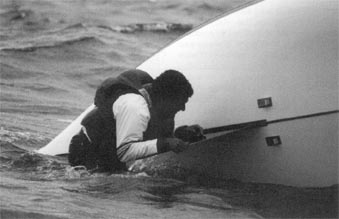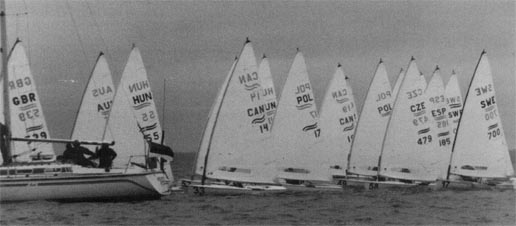12. So You Want To Start Sailing The Finn? |
by Philippe Rogge |
|
It is good to see so many new sailors joining our class every year. Some of them make it to the top of their potential fairly quickly - while for others it takes a little longer to get right. Having been around for a while one quite easily picks out the good Finn campaigns from the bad. So, what do you do if you want to start sailing the Finn seriously?
Fitness
I am not going to spend a lot of time on this subject as it is covered elsewhere, but your first and foremost investment should be in your physical fitness. Whatever hull, mast or sail you have the differences in the Finn between first and second, and between the men and the boys, are made at the end of that last beat when you've been hiking for so long you can't even think straight anymore. So make sure you invest plenty of time in physical training.
|
Boat
Let's start at the beginning. You need a boat. Nowadays it's fairly easy to find a good second hand boat. When I started in 1990 it was all a bit of a mystery. Some of the old Vanguards were reputed to be softer and better than the others (as proven by regatta results), and the new ones were too stiff. So you kind of had to get lucky. Nowadays, the boats have changed a lot. A number of new builders have entered the market (Devoti, Lemieux, Mader, Pata). Their models keep changing every couple of years. To figure out what the best are, check what the top guys are using. They will have tried all the boats, so there is no need for you to do it again. One rule of thumb: 'Don't outsmart the fleet'. You don't want your sailing skills to be overshadowed by question marks about your boat, which is different from the top guys.
|
 |
|
Sure, you can get a good deal and yes, it probably was fast at some point, but be sensible and buy a boat like (or from) one of the top guys. When buying a second hand boat do check for damage and general hull condition. It may also be wise to ask which mould or generation the boat is, as all builders do change moulds from time to time.
Old or New?
New is more fun, but you'll pay a lot more for that extra shine. The boat construction and the materials used are so good that a cheap secondhand boat will still win races and is a perfect compromise to get started. Talk to top sailors (who will swap boats regularly for no apparent reason to you), your national Finn secretary and the boat builders to find that good deal. If you maintain it well, it'll provide years of good service.
|
Booms
Booms are fairly straightforward. For decades now, there's only been one boom (Needlespar, UK). It's a bit heavier than the rules allow, but most guys will be using those. There are a number of lighter booms (we're talking about a difference of about the weight of a can of Coca Cola) out there, like Holt in the UK (with the advantage of 'head friendly' rounded corners), but there's no need to get carried away by those small differences when you're starting out. Focus on the basics.
Mast
Masts are a different story altogether - but again, don't outsmart the rest. Your best strategy is to buy a second hand mast from one of the top guys. Because these guys try so many masts all year round, they will also have 'lemons' (the ones that leave a sour taste in your mouth).
|
 |
|
You must make sure it's a mast that has actually been used in a big regatta. Major Championship stickers or stamps on a mast are usually a good sign. At that time, the guy thought it was a good enough mast to use. Just make sure that it's not from a previous generation. A mast measured in 1995 would already be from a previous generation (although I expect major mast developments to slow down). |
Wing or Round?
I don't believe there's a major difference between them, but since most builders only build wings, you'll probably end up with a wing mast anyway. You will want to try it out with your sail. We'll get to the sails later, but your mast choice must be linked to sails. He may want to sell you one of his sails to go on the mast, and that would be a good solution. Anyway, put it up, try it out and ask him (and some others) for advice. You can always get a new sail made to the same specifications from the sail maker.
Stiff or soft?
It is difficult to give accurate advice on stiffness, as everything is so relative to your boat, your weight, your sail and the conditions you're going to be sailing in. If you do want advice, though, here's my theory. Unless you're only going to be sailing on small lakes, you need a mast which is stiff in the bottom (fore and aft and sideways). Moving up your mast, it should start getting softer sooner (especially sideways) if you're light or higher up if you're heavy. Masts which are soft fore and aft will not give you a lot of power through waves. Masts which are stiff sideways will be great for pointing, but once the breeze or chop picks up, you won't be able to open that leech and go fast.
|
 |
|
So in short: stiff fore and aft (minimum 'normal rake' should not be less than 6.70 meters or you'll lose too much downwind) and softer sideways, depending on your weight. If you're a pure lake sailor, you can afford a mast that's softer fore and aft (and stiffer sideways). ('Stiff and 'soft' are obviously all very relative. With the appearance of plastic sails, most older masts will be too soft for a plastic sail.)
|
Buying a New Mast
If you can't buy a mast from a top sailor, you could buy a new one. However, do make sure you buy it off one of the reputed mast makers. Tell them your weight and skill level and those guys will know what a good 'all round' mast is. Sure, your first mast will not be perfect in all conditions. Different masts and mast/sail combinations are better in different conditions. You need to try it out in all conditions to see what its 'range' is. Try to buy something which is fairly 'all-round'. As a general rale I'd say: if you're going to be sailing on flat waters a lot, buy a mast which is stiff fore and aft and a flat sail. If you're planing to do a lot of racing on the sea or large inland waters, buy a somewhat softer mast with a fuller sail. The key here is 'all-round'. You'll have to get to know your mast for a while, and only then will it work for you. Don't expect it to go automatically from the word go.
|
 |
|
Sails
Sail choice is as complex as mast choice. Whether you buy a second hand mast from a top sailor or a new one from a builder or sailing shop, always ask them what sails go well with that type of mast (it's always better to have a look at a regatta yourself). Have them measure your mast (or even better, do it yourself if you know how to) and send those numbers (and the method they used to measure it) to a sailmaker who's used to working with mast deflection numbers. With computer technology now having entered the sailmaking business, most sailmakers will be able to help you out.
|
Most of the top sailors now have a working relationship with a sailmaker. That means that the major Finn sailmakers will have at least one guy in his loft who knows the class and what's going on. Call him for advice.
What sailmaker to choose? Well, as before, it will depend on your choice of mast and what type of waters you'll be sailing on. What sailcloth to use? With the recent development of 'plastic' or laminated sails, cloth choice can be difficult. Ask your sailmaker to get you an 'all round' sail which will get you through light drifter, medium choppy conditions and a strong breeze. You won't be the fastest in any conditions, but on average you should be up there.
|
 |
|
Simple really. If you buy a sail and it doesn't really fit the mast, you need at least to get the luff curve (i.e. the amount of bend in the front part of your sail - the luff - when you put the sail flat on the ground) to fit the mast. If you don't know how to do it, ask advice from another sailor or from a sailmaker with experience in dinghy sailing. It can be hard to get it right, but it does matter a lot. The old style soft Dacron is not very 'all round' anymore. If you're going to buy one sail, buy a plastic (or laminated) one or a very light yarn tampered 'new style' Dacron sail.
|
 |
Care
Take good care of your equipment. Make sure you get strong covers. You should at least get a cover for your mast and a bottom cover for the boat (a top cover will prevent the gel coat from losing its colour when exposed to the sun). Also get a decent dolley and a good road trailer with adequate suspension.
It's good practice to put some extra foam or a mattress underneath your boat when travelling.
|
 |
|
Remove salt water from your boat after each sail and make sure the boat doesn't stay wet for long periods. This way you'll enjoy your investment to the full.
Learning from Others
Talk to other, more experienced sailors. Most sailors will be open for questions, and you can learn a lot. If you have a coach, he may know another guy he used to sail against who's a coach in the Finn nowadays. If you don't ask, you'll never get an answer. When travelling abroad at regattas, make arrangements to stay with other Finn sailors during events. You'll learn a lot about sailing, but also about what they do before and after sailing, concentration, food, fitness and relaxation. |
Finally, let me share with you the secret to most failed start-ups. It's the guy who has a special arrangement with his local mast builder or sailmaker. He gets the equipment for free if he only uses that one. Remember the rule of thumb? Right. If you don't know what the Finn is about, you won't be learning about the developments of the best gear around and your local mast (or sail) maker won't be learning a lot either. Leave it to the top guys to experiment. Or you'll never know how good you could have been if it hadn't been for those masts.
|
 |
The Finn class is not only about the boat. It's about the people. You'll enjoy your sailing and make friends for life. Good sailing and remember, Rome wasn't built in a day!
|
|
|